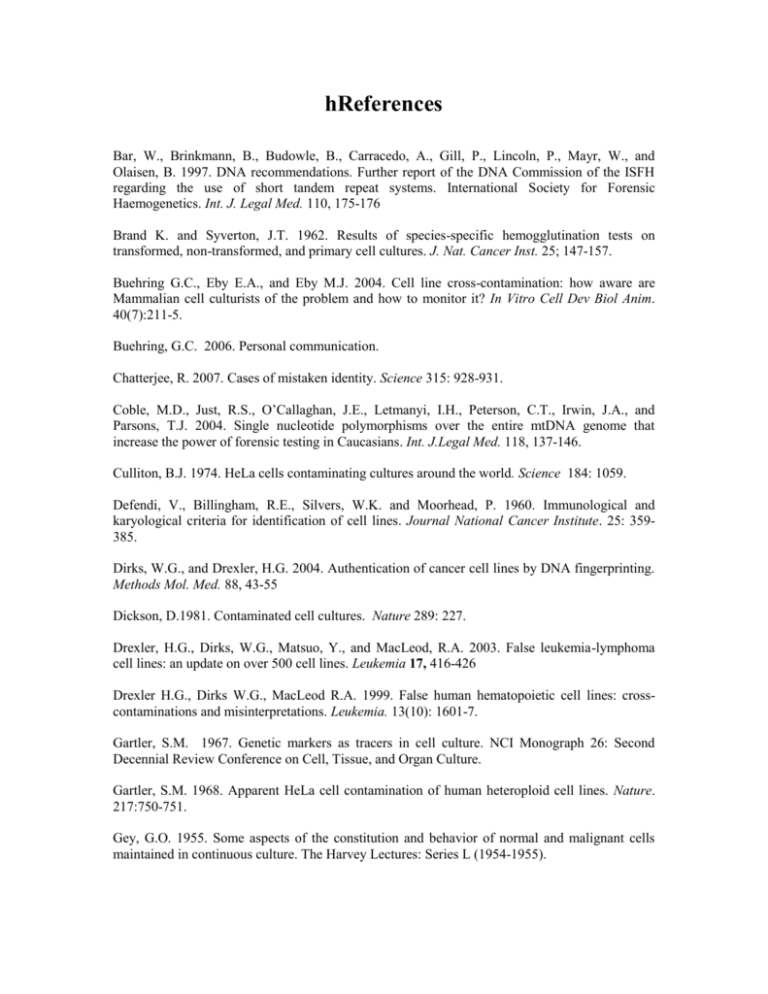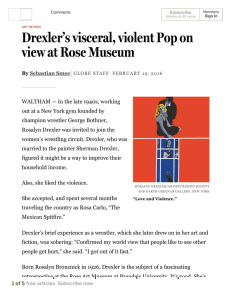References - Cell Line Authentication Global Awareness Month
advertisement

hReferences Bar, W., Brinkmann, B., Budowle, B., Carracedo, A., Gill, P., Lincoln, P., Mayr, W., and Olaisen, B. 1997. DNA recommendations. Further report of the DNA Commission of the ISFH regarding the use of short tandem repeat systems. International Society for Forensic Haemogenetics. Int. J. Legal Med. 110, 175-176 Brand K. and Syverton, J.T. 1962. Results of species-specific hemogglutination tests on transformed, non-transformed, and primary cell cultures. J. Nat. Cancer Inst. 25; 147-157. Buehring G.C., Eby E.A., and Eby M.J. 2004. Cell line cross-contamination: how aware are Mammalian cell culturists of the problem and how to monitor it? In Vitro Cell Dev Biol Anim. 40(7):211-5. Buehring, G.C. 2006. Personal communication. Chatterjee, R. 2007. Cases of mistaken identity. Science 315: 928-931. Coble, M.D., Just, R.S., O’Callaghan, J.E., Letmanyi, I.H., Peterson, C.T., Irwin, J.A., and Parsons, T.J. 2004. Single nucleotide polymorphisms over the entire mtDNA genome that increase the power of forensic testing in Caucasians. Int. J.Legal Med. 118, 137-146. Culliton, B.J. 1974. HeLa cells contaminating cultures around the world. Science 184: 1059. Defendi, V., Billingham, R.E., Silvers, W.K. and Moorhead, P. 1960. Immunological and karyological criteria for identification of cell lines. Journal National Cancer Institute. 25: 359385. Dirks, W.G., and Drexler, H.G. 2004. Authentication of cancer cell lines by DNA fingerprinting. Methods Mol. Med. 88, 43-55 Dickson, D.1981. Contaminated cell cultures. Nature 289: 227. Drexler, H.G., Dirks, W.G., Matsuo, Y., and MacLeod, R.A. 2003. False leukemia-lymphoma cell lines: an update on over 500 cell lines. Leukemia 17, 416-426 Drexler H.G., Dirks W.G., MacLeod R.A. 1999. False human hematopoietic cell lines: crosscontaminations and misinterpretations. Leukemia. 13(10): 1601-7. Gartler, S.M. 1967. Genetic markers as tracers in cell culture. NCI Monograph 26: Second Decennial Review Conference on Cell, Tissue, and Organ Culture. Gartler, S.M. 1968. Apparent HeLa cell contamination of human heteroploid cell lines. Nature. 217:750-751. Gey, G.O. 1955. Some aspects of the constitution and behavior of normal and malignant cells maintained in continuous culture. The Harvey Lectures: Series L (1954-1955). Gilbert, D.A.; Reid, Y.A.; Gail, M.H., Pee, D., White, C., Hay, R.J., O’Brien, S.J. 1990. Application of DNA fingerprints for cell-line individualization. Am. J. Hum. Genet. 47:499-514. Gill, P., Brinkmann, B., d’Aloja, E., Andersen, J., Bar, W., Carracedo, A., Dupuy, B., Eriksen, B., Jangblad, M., Johnsson, V., et al. 1997. Considerations from the European DNA profiling group (EDNAP) concerning STR nomenclature. Forensic Sci. Int. 87, 185-192. Harris, N., Gang, D., Quay, S., Poppema,S.,Zamecnik,P.,Nelson-Rees, W., and O’Brien, S.J. 1981. Contamination of Hodgkin’s disease cell cultures. Nature 289,228-230. Kniss D.A., Xie Y., Li Y., Kumar S., Linton E.A., Cohon P., Fan-Harvard P., Redman C.W., Sargent, IL. 2002. ED(27) trophoblast-like cells isolated from first-trimester chorionic villi are genetically identical to HeLa cells yet exhibit a distinct phenotype. Placenta. 23(1):32-43. Lavappa K.S. 1978. Survey of ATCC stocks of human cell lines for HeLa contamination. In Vitro. 14(5):469-75. Lee, J.Y., Lee, C.H., Shim, S.H., Seo, H.K., Kyhm, J.H., Cho, S., and Cho, Y.H. 2002. Molecular cytogenetic analysis of the monoblastic cell line U937. karyotype clarification by Gbanding, whole chromosome painting, microdissection and reverse painting, and comparative genomic hybridization. Cancer Genet. Cytogenet. 137, 124-132 Liscovitch, M. and Ravid, D. 2006. A case study in misidentification of cancer cell lines: MCF7/AdrR cells (re-designated NCI/ADR/RES) are derived from OVCAR-8 human ovarian carcinoma cells. Cancer Lett. Feb. 24. MacLeod R.A., Dirks W.G., Matsuo Y., Kaufmann M., Milch H., Drexler, H.G. 1999. Widespread intraspecies cross-contamination of human tumor cell lines arising at source. International Journal of Cancer. 83(4):555-63. Masters, J.R. 2002. HeLa cells 50 years on: the good, the bad and the ugly. Nat. Rev. Cancer. 2:315-319. Masters, J.R. 2005. DNA profiling and the authentication of cell lines. In Vitro Cell. Develop. Biol. 41 (abstract) 6A. Masters, J.R.; Thomson, J.A.; Daly-Burns, B., et al. 2001. Short tandem repeat profiling provides an international reference standard for human cell lines. Proc. Natl. Acad. Sci. USA. 98:80128017. Masters, J.R.W.; Bedford, P.; Kearney, A.; Povey, S. and Franks, L.M. 1988. Bladder cancer cellline cross-contamination: Identification using a specific locus-specific minisatellite probe. Brit. J. Cancer. 57, 284-286. Melcher, R., Maisch, K., Koehler, S., Bauer, M., Steinlein, C., Schmid, M., Kudlich, T., Schauber, J., Luehrs, H., Menzel, T., and Sceppach, W. 2005. SKY and genetic fingerprinting reveal a cross-contamination of the putative normal colon epithelial cell line NCOL-1. Cancer Genetics and Cytogenetics. 151(1): 84-87. Milanesi, E., Ajmone-Marsan, Bignotti Losio, M.N., Bernardi, Jo, Chegdani, F, Sorcini, M. and Ferrari, M. 2003. Molecular detection of cell line cross-contaminations using amplified fragment length polymorphism DNA fingerprinting technology. In Vitro Cell Div. Biol. – Animal. 39: 124130. Muller, S., Eder, V., and Wienberg, J. 2004. A nonredundant multicolor bar code as a screening tool for rearrangements in neoplasia. Genes Chromosomes Cancer 39, 59-70 Nelson-Rees, W., Flandermeyer, R., and Hawthorne, P. 1974. Banded marker chromosomes as indicators of intraspecies cellular contamination. Science. 184, 1093-1096 Nelson-Rees, W., and Flandermeyer, R. 1977. Inter-and Intra-species contamination of human breast tumor cell lines HBC and Br Ca5 and other cell cultures. Science. 195, 1343-1344. Nelson-Rees W.A., Daniels D.W., Flandermeyer R.R. 1981. Cross-contamination of cells in culture. Science. 212(4493):446-52. Review. Nelson-Rees, W. 2004. Acceptance speech, Lifetime Achievement Award, Annual Meeting, Society for in Vitro Biology (personal communication). O’Brien SJ (2001) Cell culture forensics. Proc Natl Acad Sci USA, 98, 7656-7658. O’Brien SJ, Kleiner G, Olson R & Shannon J.E. 1977. Enzyme polymorphisms as genetic signatures in human cell cultures. Science, 195, 1345-1348. Ogura H., Fujii R., Hamano M., Kuzuya M., Nakajima H., Ohata R., Mori T. 1997. Detection of HeLa cell contamination-presence of human papillomavirus 18 DNA as HeLa marker in JTC-3, OG and OE cell lines. Jpn J Med Sci Biol. 50(4-5):161-7. Parson, Walther, Romana Kirchebner, Roswitha Muhlmann, Kathrin Renner, Anita Kofler, Stefan Schmidt, and Reinhard Kofler. 2005. Cancer cell line identification by short tandem repeat profiling: power and limitations. The FASEB Journal express article 10.1096/fj.04-3062fje. Rothfels, K.K. Axelrod, A., Siminovitch, L., McCullogh, E., and Parker, R.C. 1958. The origin of altered cell lines from mouse, monkey, and man, as indicated by chromosome and transplantation studies. Proc. 3rd Canadian Cancer Research Conference, 1988. Berg, R.W. ed, New York Academic Press, Inc. 189-214. Satoh, M. and Takeuchi, M. 1993.Cross-contamination of cell lines as revealed by DNA fingerprinting in the IFO animal cell bank. Res Commun Inst Ferment. 16 18-23. Stacey, G.N.; Bolton, B.J.; and Doyle, A. 1992. DNA fingerprinting transforms the art of cell authentication. Nature (Lond.). 357:261-262. Steube K.G., Meyer C., Uphoff C.C., Drexler H.G. 2003. A simple method using beta-globin polymerase chain reaction for the species identification of animal cell lines—a progress report. InVitro Cell Dev Biol Anim. 39(10):468-75. van Helden P.D., Wiid I.J., Abrecht C.F., Theron E., Thornley A.L., and Hoal-van Helden E.G. 1988. Cross-contamination of human esophageal squamous carcinoma cell lines detected by DNA fingerprint analysis. Cancer Res. 48(20):5660-2.









